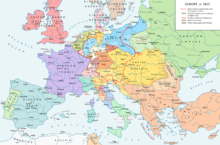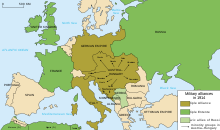European balance of power
The European balance of power is a tenet in
History
Antiquity to Crusades
The emergence of city-states (
The
Among the successor kingdoms in the West, that of the
Most of the crusades did not achieve their objective, but some of them had a massive impact on the political and economic landscape of Europe: the
Crusades to Westphalia
Portugal formed the first European colonial empire in 1415 with the
The papacy launched the
Stately quadrille
In the 16th and 17th centuries,
In the 18th century, this led to the
19th century

After the end of the Napoleonic Wars, during which France directly or indirectly controlled much of Europe except for Russia, and the Holy Roman Empire was dissolved, the Concert of Europe tried to maintain the balance of power. The territorial boundaries agreed to by the victorious Great Powers (Prussia, Austria, Russia and Great Britain) at the Congress of Vienna in 1815 were maintained, and even more important there was an acceptance of the theme of balance with no major aggression.[16] Otherwise the Congress system says historian Roy Bridge, "failed" by 1823.[17] In 1818, the British decided not to become involved in continental issues that did not directly affect them. They rejected the plan of Tsar Alexander I to suppress future revolutions. The Concert system fell apart as the common goals of the Great Powers were replaced by growing political and economic rivalries.[18] Artz says the Congress of Verona in 1822 "marked the end."[19] There was no Congress called to restore the old system during the great revolutionary upheavals of 1848 with their demands for revision of the Congress of Vienna's frontiers along national lines.[20]
Britain, with its naval, maritime, commercial and financial dominance, was committed to the European balance of power after 1815.[21] Between the 1830s and 1850, Britain and France were the strongest powers in Europe, but by the 1850s they had become deeply concerned by the growing power of Russia, which had expanded westward towards Central Europe, and Prussia, which was increasingly assuming greater control and influence over the German lands, aside from Austria. The Crimean War of 1854–55 and the Italian War of 1859 shattered the relations among the Great Powers in Europe.[22]
The creation in 1871 and rise of the Prussian-led German Empire (excluding Austria) as a dominant nation (Prussia had quickly defeated both Austria and France in wars) restructured the European balance of power. For the next twenty years, Otto von Bismarck managed to maintain the balance of power, by proposing treaties and creating many complex alliances between the European nations such as the Triple Alliance.[23][24][25]
World Wars

After 1890, the German Emperor
This idea floundered as Europe split into three principal factions in the 1920s and 1930s:
Post-World War II: Cold War period
During the post-Second World War era, the Allies split into two blocs, a balance of power emerged among the Eastern Bloc (affiliated with the Soviet Union and the Socialist nations of Central and Eastern Europe, Central Asia, and the Caucasus), the Western Bloc (affiliated with the Western democracies, particularly France, the United States, and the United Kingdom), and neutral or non-aligned countries (including Ireland, Sweden, Switzerland, Austria, and Yugoslavia), with German lands divided up between them respectively as East Germany and West Germany until 1989. Most Western Bloc countries came together under the military alliance of NATO, while the Eastern Bloc countries formed the Warsaw Pact. The first NATO Secretary General, the British Lord Ismay, famously stated the organization's initial goal was "to keep the Russians out, the Americans in, and the Germans down."[29]
Post-Cold War era
The three most powerful members of the
The term
However, there continues to be a wider, strategic balance of Western and (now) Russian power, albeit with the boundary between the two pushed further east since the
See also
- Balance of power (international relations)
- Concert of Europe
- Great power
- International relations (1814–1919)
- Precedence among European monarchies
- Treaty of Versailles
References
- ^ René Albrecht-Carrié, A Diplomatic History of Europe Since the Congress of Vienna (1958), 736pp; a basic introduction, online free to borrow
- S2CID 145419574.
- ^ Daniel Deudney, "'A Republic for Expansion': The Roman Constitution and Empire and Balance-of-Power Theory." The Balance of Power in World History (Palgrave Macmillan, London, 2007) pp. 148–175. online
- ^ Collins 1989, p. 147; Reilly 1993, pp. 75–76; Deyermond 1985, p. 346; Hillgarth 2009, p. 66 n. 28
- ^ "Balance of power INTERNATIONAL RELATIONS". Encyclopaedia Britannica. Retrieved June 8, 2019.
- ^ Bryce Lyon, Medieval Constitutionalism: A Balance of Power (1961).
- ^ "Renaissance | Definition, Meaning, History, Artists, Art, & Facts | Britannica". www.britannica.com. Retrieved 2023-08-12.
- ISBN 978-1789017182.
- ISBN 978-1440848568– via Google Books.
- ISBN 978-1137069771. Archived from the originalon 7 April 2022.
- ^ Parker 1984, p. 189.
- ^ Éric Schnakenbourg, Fabrice Jesne. "The European Balance of Power". EHNE. Retrieved June 8, 2019.
- ^ "Balance of power INTERNATIONAL RELATIONS". Encyclopaedia Britannica. Retrieved June 8, 2019.
- ^ MacKenzie, Philip (1996). Equilibrium: An Analysis of the Balance of Power Between European Nations. New York: Granger Press. p. 275.
- ^ John R. Davis, "Britain and the European balance of power." A companion to nineteenth-century Britain (2004): 34+ online
- ^ Gordon Craig, "The System of Alliances and the Balance of Power." in J.P.T. Bury, ed., The New Cambridge Modern History, Vol. 10: The Zenith of European Power, 1830–70 (1960) p 266.
- ^ Roy Bridge, "Allied Diplomacy in Peacetime: The Failure of the Congress 'System,' 1815–23" in Alan Sked, ed., Europe's Balance of Power, 1815–1848 (1979), pp 34–53
- ^ C.W. Crawley, "International Relations, 1815–1830" in C.W. Crawley, ed., The New Cambridge Modern History: Volume 9, War and Peace in an Age of Upheaval, 1793–1830. Vol. 9 (1965) pp 669–71, 676–77, 683–86.
- ^ Frederick B. Artz, Reaction & Revolution: 1814–1832 (1934) p 170.
- ^ Paul W. Schroeder, The Transformation of European Politics: 1763–1848 (1996) p 800.
- ^ John R. Davis, "Britain and the European Balance of Power," in Chris Williams, ed., A Companion to Nineteenth‐Century Britain (2004) pp 34–52.
- ^ René Albrecht-Carrié, A diplomatic history of Europe since the Congress of Vienna (1958) pp 65–68, 84–106.
- ^ Erich Eyck, Bismarck and the German Empire (1964) pp 58–68
- ^ René Albrecht-Carrié, A diplomatic history of Europe since the Congress of Vienna (1958) pp 163–206.
- ^ The Balance of Power. A System of Peace in European International Politics Case Example: Congress of Vienna 1814/1815. GRIN. 2 December 2016. Retrieved June 8, 2019.
- ^ Christopher Clark, Kaiser Wilhelm II (2000) pp 35–47
- ^ John C.G. Wilhelm II: the Kaiser's personal monarchy, 1888–1900 (2004).
- ^ Raff, Diethher (1988), History of Germany from the Medieval Empire to the Present, pp. 34–55, 202–206
- ^ Reynolds 1994, p. 13.
- ^ "Brexit, Germany, and the European Balance of Power". Blogactiv. October 23, 2018. Archived from the original on June 8, 2019. Retrieved June 8, 2019.
Bibliography
- Albrecht-Carrié, René. A Diplomatic History of Europe Since the Congress of Vienna (1958), 736pp; basic survey
- Bartlett, C. J. Peace, War and the European Powers, 1814–1914 (1996) brief overview 216pp
- Clark, Christopher. Iron Kingdom: The Rise and Downfall of Prussia 1600–1947. Penguin Books, 2007
- ISBN 0-631-15923-1.
- Deyermond, Alan (1985). "The Death and Rebirth of Visigothic Spain in the Estoria de España". Revista Canadiense de Estudios Hispánicos. 9 (3): 345–67.
- Hillgarth, J. N. (2009). The Visigoths in History and Legend. Toronto: Pontifical Institute for Medieval Studies.
- Kennedy, Paul. The Rise and Fall of the Great Powers Economic Change and Military Conflict From 1500–2000 (1987), stress on economic and military factors
- Kissinger, Henry. Diplomacy (1995), 940pp; not a memoir but an interpretive history of international diplomacy since the late 18th century
- Langer, William. An Encyclopedia of World History (5th ed. 1973); highly detailed outline of events
- ISBN 978-0-415-12883-4.
- Reilly, Bernard F. (1993). The Medieval Spains. Cambridge Medieval Textbooks. Cambridge, UK: Cambridge University Press. ISBN 0-521-39741-3.
- Reynolds, David (1994). The Origins of the Cold War in Europe: International Perspectives. Yale University Press. ISBN 978-0-300-10562-9.
- Simms, Brendan. Three Victories and a Defeat. Penguin Books, 2008.
- Strachan, Hew. The First World War. Simon & Schuster, 2006
